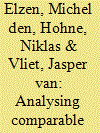|
|
|
Sort Order |
|
|
|
Items / Page
|
|
|
|
|
|
|
| Srl | Item |
| 1 |
ID:
091698


|
|
|
|
|
| Publication |
2009.
|
| Summary/Abstract |
EU Heads of State and Government agreed in March 2007 that the EU will reduce its greenhouse gas emissions to 30% below 1990 levels by 2020 within an international post-2012 climate agreement, provided that other developed (Annex I) countries commit to comparable reductions. Within this context, this paper first explores the pros and cons of many possible conceptual approaches to assess the comparability of the mitigation efforts by Annex I countries. We selected six approaches for further analysis, which represent efforts well and are technically feasible. The implications of each of these six approaches were analysed in terms of the reductions and abatement costs that must be made by different Annex I countries to meet an aggregate reduction of 20% and 30%, respectively, below 1990 levels by 2020. The analysis indicates that significant reductions are necessary for all developed countries. This study shows that reductions by the EU of at least 30%, combined with comparable reduction efforts by other developed countries to meet the aggregate Annex I reduction target of 30% by 2020 and support of developed countries for developing countries to keep their emissions 15-30% below the baseline, are sufficient to achieve the EU climate goal of 2 °C.
|
|
|
|
|
|
|
|
|
|
|
|
|
|
|
|
| 2 |
ID:
128441


|
|
|
|
|
| Publication |
2014.
|
| Summary/Abstract |
Many of the major greenhouse gas emitting countries have planned and/or implemented domestic mitigation policies, such as carbon taxes, feed-in tariffs, or standards. This study analyses whether the most effective national climate and energy policies are sufficient to stay on track for meeting the emission reduction proposals (pledges) that countries made for 2020. The analysis shows that domestic policies of India, China and Russia are projected to lead to lower emission levels than the pledged levels. Australia's and the EU's nationally legally binding policy framework is likely to deliver their unconditional pledges, but not the conditional ones. The situation is rather unclear for Japan, South Korea, Brazil and Indonesia. We project that policies of Canada and the USA will reduce 2020 emission levels, but additional policies are probably needed to deliver their pledges in full. The analysis also shows that countries are implementing policies or targets in various areas to a varying degree: all major countries have set renewable energy targets; many have recently implemented efficiency standards for cars, and new emission trading systems are emerging.
|
|
|
|
|
|
|
|
|
|
|
|
|
|
|
|
| 3 |
ID:
099252


|
|
|
|
|
| Publication |
2010.
|
| Summary/Abstract |
This paper analyses the environmental and financial consequences of various strategies of dealing with surplus emission allowances in the aftermath of the Copenhagen Accord. This topic remains relevant, in particular, with respect to the Russian negotiation position, as this country is the largest holder of surplus emissions. It is concluded that not addressing the surplus problem is not a feasible negotiation option, as the sheer size of the surpluses would jeopardise the environmental integrity of any future agreement. Cancelling surpluses against Russia's will, though viable, is not desirable, as it might well lead to this country opting out of this climate treaty. Three options for compromise have been selected and analysed here: (1) stricter targets for Annex I countries; (2) strategic reserve for Russia; (3) institutionalising optimal banking. It is concluded that, whereas option 1 is environmentally the best, in the present political context it is probably less feasible. The other two options, although environmentally suboptimal, seem politically more favourable. Our analysis suggests that maximal revenues for surplus-holding countries arise by releasing only a limited amount of surplus credits to the market. The institutionalisation of this effect could be a key lever to a politically feasible agreement on surplus emissions.
|
|
|
|
|
|
|
|
|
|
|
|
|
|
|
|
| 4 |
ID:
150784


|
|
|
|
|
| Summary/Abstract |
In June 2015, China announced its post-2020 reduction targets, its central element being the intention to peak CO2 emissions by 2030 or earlier. China has implemented several policies to reduce its greenhouse gas (GHG) emissions. This study provides emission projections for China up to 2030 given current policies and a selected set of enhanced policies, and compares the results with projected CO2 emission trajectories that are consistent with the announced target for 2030. The projections are based on existing scenarios and energy system and land use model calculations. We project that the 2030 CO2 emission level consistent with a peak in CO2 emissions by 2030 ranges from 11.3 to 11.8 GtCO2. The corresponding total GHG emission level ranges from 13.5 to 14.0 GtCO2e in 2030. Current policies are likely not to be sufficient to achieve the 2030 targets, as our projected total GHG emission level under current policies ranges from 14.7 to 15.4 GtCO2e by 2030. However, an illustrative set of enhancement policy measures, all of which are related to national priorities, leads to projected GHG emission levels from 13.1 to 13.7 GtCO2e by 2030 – and thus below the levels necessary for peaking CO2 emissions before 2030.
|
|
|
|
|
|
|
|
|
|
|
|
|
|
|
|
|
|
|
|
|